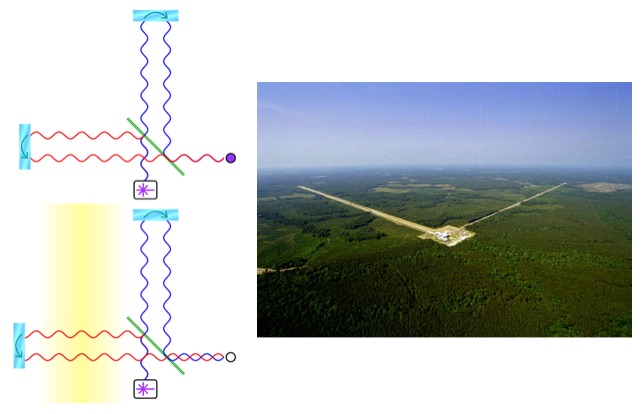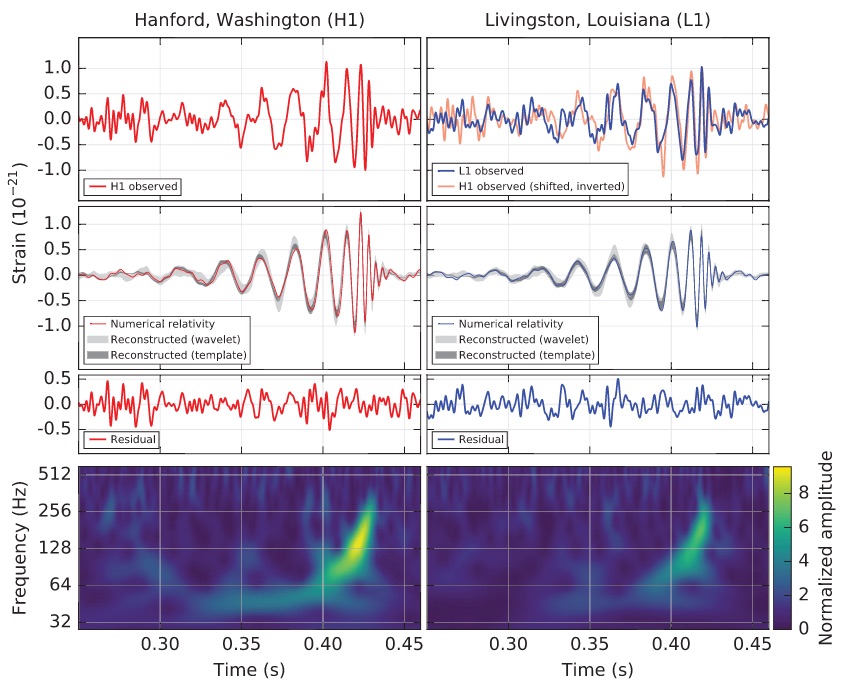Physicist: A few days ago we managed to detect gravity waves for the first time. Gravity waves were predicted a century ago by Einstein as a consequence of his general theory of relativity. This success isn’t too surprising from a theoretical stand point; if
your theories are already batting a thousand, then when they bowl yet another field
goal for a check mate no one is shocked.
What is amazing is not that gravity waves exist, but that we’ve managed to detect
them. The effect is so unimaginably small that it can be overwhelmed by someone
stubbing their toe a mile away or filing their taxes wrong. Gravity is literally
the geometry of spacetime: very particular, tiny increases and decreases in
distances and durations. There’s a fairly standard technique for doing this: light
is bounced back and forth along two separate paths between mirrors (in this case the
length of those two paths are each 4km) dozens of times. The light from these two
paths is then brought together and allowed to interfere. If the difference in the
length of the two paths changes by half a wave length, then instead of destructive
interference we see constructive interference. The actual path difference is
substantially less than half a wave length, but it’s still detectable.

A gravity wave detector is a device that very, very carefully measures the difference between the lengths of two long paths. (Left) The tiny difference is detected by looking at the interference between lasers that travel along each path. (Right) What the detector in Livingston, LA looks like from above.
When a gravity wave ripples through the Earth, the lengths of the two paths change
by about one part in 1021 which is a tiny fraction of the width of a proton over 4 km. Keep in mind that the light that’s doing the measuring is bouncing off of mirrors that are made of atoms (each of which is much bigger than a proton) and that those atoms are constantly jiggling, because that’s what any level of heat does to matter. This level of precision is the most impressive part of this whole accomplishment. Your heart beat is currently throwing around the building you’re in by a lot more than a proton’s width. And yet, despite the fact that the literally everything in the world is a source of experiment-ruining noise, LIGO is able to filter all of it out and then go on to detect the ridiculously faint signal of a couple of black holes a fair fraction of the universe away and even sort out details of the event.
The signal that we’re hearing about now was actually detected in September. The cause appears to be the merging of two black holes about 1.3 billion lightyears away (which puts the source well outside of our backyard). These black holes started with masses of around 36 and 29 times the mass of the Sun and after combining left a black hole with a combined mass of about 62 Sun-masses. Astute second graders will observe that 36+29>62. This is because gravity waves carry energy. In this case the final event turned about 3 Sun’s worth of energy into ripples in spacetime that are “loud” enough to literally (albeit very, very slightly) rattle everything in the universe. So, if we ever contact aliens from the other side of the universe and they also have nerds, then we’ll have something to talk about. By the way, this signal (unlike so many in physics) has a frequency well within the range of human hearing. Properly cleaned up, it sounds like this.

(Top) The signal as detected at the two observatories. The noise is bad enough that without at least two observatories it would be much more difficult to see it.
(Middle) The signal as predicted by our understanding of general relativity. (Bottom) The remaining noise after the signal has been subtracted. Notice that it is now fairly constant.
(Picture on the bottom) This is a plot of the strength of the signal using color vs. frequency on the vertical axis and time on the horizontal axis.
This is the first direct measurement of gravity waves, but it isn’t the first evidence we’ve seen. If you have two really heavy masses in orbit around each other, you’ll find that they’ll slowly spiral together. This is strange because it implies that the masses are losing energy. But to what? We first measured this effect with pulsars, which are a kind of neutron star (the next densest things after black holes). Pulsars are so named because they produce radio pulses that are extremely regular. You can think of them as giant space clocks. They’re precise enough that they allow us to figure out exactly how they’re moving using doppler shifts, and they’ve shown that closely orbiting pairs lose energy in exactly the way we’d expect based on our theoretical understanding of gravity waves.
So what can we use this for? So far we’ve been able to “hear” black holes merging (several more times since September). We’re not only detecting the spiraling in, but also the process of the black holes coalescing. Once they come in contact they briefly form an unshelled-peanut-shaped black hole before assuming a spherical shape. This process is called the “ring down” and it also creates audible gravity waves that give us information about the behavior of black holes. But beyond heavy things in tight orbits and ringing black holes, what will we hear? Short answer: who knows. If you go out in the woods you’ll hear trees falling over when no one is around and lots of bears shitting, but there’s no telling what else you’ll hear. The only way to find out is to go out and listen. As our gravity wave detectors get better and more plentiful we’ll be able to hear fainter and fainter signals. We can expect to hear lots of black holes merging; not because it’s common, but because it’s loud and the universe is big. Soon we’ll start hearing things we don’t expect and that’s when the science happens. It’s nice to have our theories regarding gravity waves proven right, but being right isn’t the point of science. As long as you’re right, you’re not learning. It’s all the things we don’t expect that will be the most exciting.
Gravity wave astronomy is only the third way we have of observing the distant universe: light, neutrinos, and now gravity waves. We didn’t know what we’d find with the first two and it’s fair to say we don’t know what we’ll learn now. Exciting times.
You can read the paper that announced the achievement here. And check out the author list: there was more collaboration on this than a Wu Tang album.
Update (6/20/2016): And again!







18 Responses to Gravity Waves!